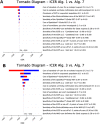Cost-effectiveness of incorporating Ebola prediction score tools and rapid diagnostic tests into a screening algorithm: A decision analytic model
- PMID: 37847703
- PMCID: PMC10581462
- DOI: 10.1371/journal.pone.0293077
Cost-effectiveness of incorporating Ebola prediction score tools and rapid diagnostic tests into a screening algorithm: A decision analytic model
Abstract
Background: No distinctive clinical signs of Ebola virus disease (EVD) have prompted the development of rapid screening tools or called for a new approach to screening suspected Ebola cases. New screening approaches require evidence of clinical benefit and economic efficiency. As of now, no evidence or defined algorithm exists.
Objective: To evaluate, from a healthcare perspective, the efficiency of incorporating Ebola prediction scores and rapid diagnostic tests into the EVD screening algorithm during an outbreak.
Methods: We collected data on rapid diagnostic tests (RDTs) and prediction scores' accuracy measurements, e.g., sensitivity and specificity, and the cost of case management and RDT screening in EVD suspect cases. The overall cost of healthcare services (PPE, procedure time, and standard-of-care (SOC) costs) per suspected patient and diagnostic confirmation of EVD were calculated. We also collected the EVD prevalence among suspects from the literature. We created an analytical decision model to assess the efficiency of eight screening strategies: 1) Screening suspect cases with the WHO case definition for Ebola suspects, 2) Screening suspect cases with the ECPS at -3 points of cut-off, 3) Screening suspect cases with the ECPS as a joint test, 4) Screening suspect cases with the ECPS as a conditional test, 5) Screening suspect cases with the WHO case definition, then QuickNavi™-Ebola RDT, 6) Screening suspect cases with the ECPS at -3 points of cut-off and QuickNavi™-Ebola RDT, 7) Screening suspect cases with the ECPS as a conditional test and QuickNavi™-Ebola RDT, and 8) Screening suspect cases with the ECPS as a joint test and QuickNavi™-Ebola RDT. We performed a cost-effectiveness analysis to identify an algorithm that minimizes the cost per patient correctly classified. We performed a one-way and probabilistic sensitivity analysis to test the robustness of our findings.
Results: Our analysis found dual ECPS as a conditional test with the QuickNavi™-Ebola RDT algorithm to be the most cost-effective screening algorithm for EVD, with an effectiveness of 0.86. The cost-effectiveness ratio was 106.7 USD per patient correctly classified. The following algorithms, the ECPS as a conditional test with an effectiveness of 0.80 and an efficiency of 111.5 USD per patient correctly classified and the ECPS as a joint test with the QuickNavi™-Ebola RDT algorithm with an effectiveness of 0.81 and a cost-effectiveness ratio of 131.5 USD per patient correctly classified. These findings were sensitive to variations in the prevalence of EVD in suspected population and the sensitivity of the QuickNavi™-Ebola RDT.
Conclusions: Findings from this study showed that prediction scores and RDT could improve Ebola screening. The use of the ECPS as a conditional test algorithm and the dual ECPS as a conditional test and then the QuickNavi™-Ebola RDT algorithm are the best screening choices because they are more efficient and lower the number of confirmation tests and overall care costs during an EBOV epidemic.
Copyright: © 2023 Tshomba et al. This is an open access article distributed under the terms of the Creative Commons Attribution License, which permits unrestricted use, distribution, and reproduction in any medium, provided the original author and source are credited.
Conflict of interest statement
The authors declare that they have no competing interests
Figures








References
-
- W. H. O. Ebola Response Team, Aylward B, Barboza P, Bawo L, Bertherat E, Bilivogui P, et al. Ebola virus disease in West Africa—the first 9 months of the epidemic and forward projections. N Engl J Med. 2014;371(16):1481–95. Epub 20140922. doi: 10.1056/NEJMoa1411100 ; PubMed Central PMCID: PMC4235004. - DOI - PMC - PubMed
-
- Aruna A, Mbala P, Minikulu L, Mukadi D, Bulemfu D, Edidi F, et al. Ebola Virus Disease Outbreak—Democratic Republic of the Congo, August 2018-November 2019. MMWR Morb Mortal Wkly Rep. 2019;68(50):1162–5. Epub 20191220. doi: 10.15585/mmwr.mm6850a3 ; PubMed Central PMCID: PMC6936163. - DOI - PMC - PubMed
Publication types
MeSH terms
Grants and funding
LinkOut - more resources
Full Text Sources
Medical
Research Materials

